
Hello, faithful readers! Today we have a tutorial on how to make two fall favorites, applesauce and apple butter. The great thing about both of these products is that they can be frozen. You can make one big batch of applesauce in the fall when apples are cheap, and then divide it into plastic containers and freeze; it will last all winter. They can be defrosted overnight in the fridge.
To make applesauce, start by peeling and coring the apples. The exact amount doesn't really matter - you can make as much as your pot will fit.

Then cut the apples into slices, and dump them into a large pot (one with a thick bottom will work better). You can add as many apple slices as will fit in the pot. Add enough water so that it covers the bottom; you only want it to be about an inch deep, regardless of how many apple slices you have in there. The apples don't need to be submerged.
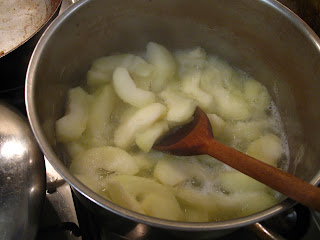
Cover with a lid and put over high heat until the water comes to a boil. Then lower the heat to let it simmer. Pretty soon the apples will start to break down - you can help them along by occasionally stirring or mashing a little with a wooden spoon:

Once they are looking fairly broken down, add some spices. We usually use cinnamon, allspice, ginger powder, and a little nutmeg. Some people like to use ground cloves, as well. Stir in the spices and watch the apples turn a nice golden color:
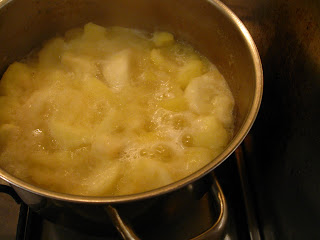
Keep stirring occasionally and cooking the sauce over low heat with the lid on. It's not too hard to tell when it's done because at that point it looks like applesauce!
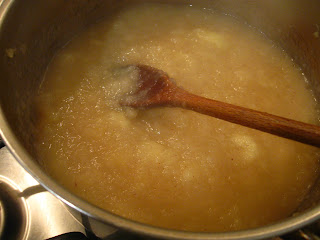
That's right, there is no pureeing or anything else complicated involved - the apples do it all themselves. Thanks, guys.
At this point you can stop and either serve the applesauce or allow it to cool before putting it into tupperware and freezing. But if you are feeling adventurous and have a lot of time on your hands, you can continue onward in pursuit of apple butter...
Apple butter, for anyone who's not aware, is a delicious form of preserves. It's sweet and spreadable, and usually is sold by the Amish. Just like jam it is suitable for preserving in jars if you go through the proper sterilization process and use plenty of sugar - but if you want to do it the easy way, just eat it within a week or two, or freeze it for later use.
To continue on to apple butter, turn the heat on your stove down to as low as possible. (If you have a small burner, use that one.) Re-cover and keep cooking for a long time - it may take a few hours total. As the apple butter cooks the color will darken - that is the sugar caramelizing:
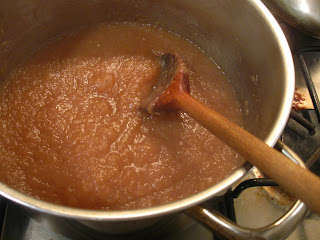
I'm not going to lie to you, faithful readers - apple butter is laborious, because you have to stir increasingly frequently as it gets closer to being done. The apple butter will thicken and will stick to the bottom of the pan, so you have to stir every few minutes and be sure to scrape the bottom repeatedly. This is a good task to do if you have something else going on and you can run back and forth between them. (Luckily, nowhere in our apartment is further than fifteen feet from the stove...)
You can tell when the apple butter is nearly done because it will greatly reduce in volume, and it will start to stiffen. When you scrape it off the bottom, it will keep its shape, like so:
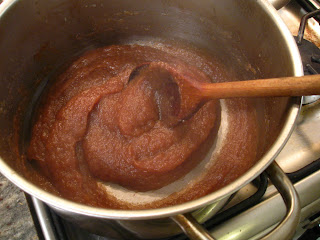
When it is fairly dark in color and has a spreadable consistency (like soft butter) you can call it done.
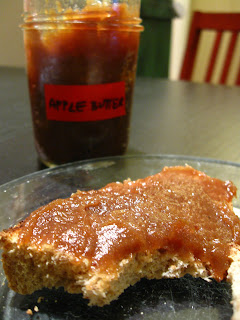
Enjoy on a piece of toast or - yum - fresh cornbread.





